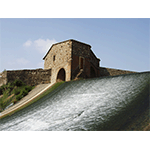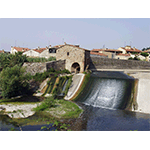Salto del "Cavalciotto" sul Bisenzio [The "Cavalciotto" Jump on the Bisenzio]
The city of Prato had a complex water canalisation system which, thanks to weirs and mill-races, crossed the city in various directions. The water of the Bisenzio was channelled upstream of Prato, in the area known as the "Cavalciotto" jump which Galileo Galilei too, commented (the hydraulic structures of "Cavalciotto" are visible from the picturesque cycle track that from Prato climbs up towards Vaiano). In the vicinity of Porta al Serraglio, the water divided into four mill-races, one of which, bound for the countryside, was utilised for agriculture and for several mills and factories, while the other three entered the city, providing motive power to various plants located there.
The menacing spates of the Bisenzio were also the object of great attention. In 1630, Grand Duke Ferdinando II de’ Medici sent Galileo, as his primary mathematician, to take part in inspections at the Bisenzio River, in the company of grand-ducal architect Giulio Parigi and engineers Alessandro Bartolotti and Stefano Fantoni. The visit was then postponed to give Galileo and Parigi the possibility to examine the proposals worked out by the engineers. Bartolotti considered eliminating the bends of the river, reducing it to a canal, while Fantoni thought the river should maintain its natural course, intervening only at the most dangerous points, particularly reinforcing the banks. The latter hypothesis was also supported by Galileo in a long letter to Raffaello Staccoli in 1631. Recognising the main cause of the floods of the Bisenzio, Fantoni and Galileo proposed to clear the river bed, removing the deposits that caused the water level to rise. As for the solutions proposed by Bartolotti, the Pisan scientist was instead critical, availing himself of mathematical reasoning. Successively, Galileo denounced the presence of the same problem for other rivers of Osmannoro, for which he recommended taking analogous measures. Studies on the Bisenzio were the motive for an exchange of letters between Galileo, Benedetto Castelli, Andrea and Niccolò Arrighetti on the problem of the speed of water currents. Galileo sent Castelli a copy of the letter he had written to Staccoli. In 1631, Cesare Marili too, wrote to Galileo about the Bisenzio, underlining the analogies between this river and the Reno.
****************************
Texts by Graziano Magrini
English translation by Victor Beard
Last update 12/gen/2008





